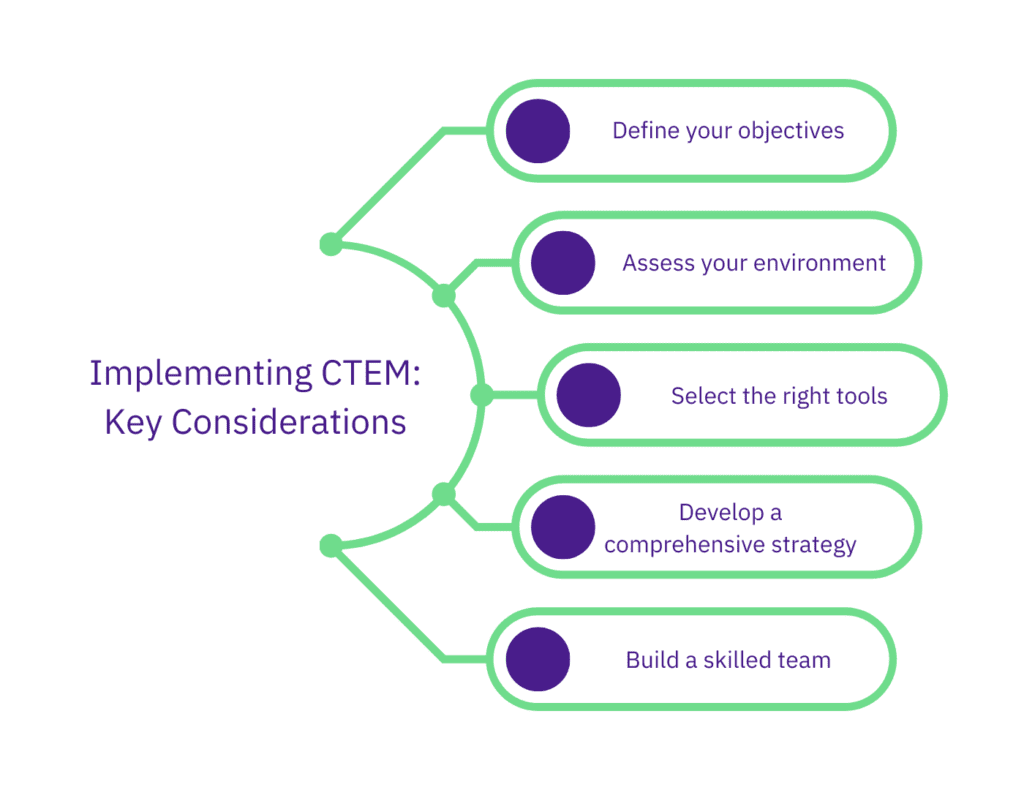Cyberattacks are growing more sophisticated by the day, especially with the advent of AI, Hackers are exploiting not just software flaws, but also misconfigurations, human error, and even unguarded cloud assets. Traditional vulnerability management, focused solely on patching known weaknesses, is like playing whack-a-mole in a volcanic eruption. It’s time for a new approach: Continuous Threat Exposure Management (CTEM). This proactive strategy goes beyond patching to provide a complete picture of your organization’s security posture, helping you anticipate and prevent attacks before they happen.
Understanding Traditional Vulnerability Management
For years, vulnerability management (VM) has been the workhorse of cybersecurity, diligently identifying, prioritizing, and fixing weaknesses in systems and software. It’s a three-pronged approach:
- Regular scans: Vulnerability scanners act like security bloodhounds, sniffing out potential flaws in software, systems, and networks.
- Prioritization: Not all vulnerabilities are created equal. VM programs rank them based on severity, how easily they can be exploited, and the potential damage they could cause.
- Remediation: Once prioritized, vulnerabilities are addressed through patches, configuration changes, or other mitigation strategies.
While these practices offer valuable defensive measures, VM programs often face limitations:
- Reactive approach: They react to identified vulnerabilities, leaving the organization exposed until vulnerabilities are addressed.
- Limited scope: They primarily focus on known vulnerabilities, potentially overlooking emerging threats or misconfigurations.
- Manual workloads: They often involve significant manual effort, leading to potential delays and inconsistencies in vulnerability remediation.
- Limited threat context: They lack comprehensive threat intelligence, making it difficult to prioritize vulnerabilities effectively.
These limitations can leave organizations vulnerable to sophisticated modern attacks that exploit previously unknown vulnerabilities, misconfigurations, or human error.
CTEM: A More Holistic Approach
Cybersecurity is a constant battle against evolving threats. Traditional vulnerability management (VM) programs have been like plugging holes in a sinking ship – they address immediate problems, but the underlying weaknesses remain. To truly stay afloat, organizations need a more comprehensive solution: Continuous Threat Exposure Management (CTEM).
Here’s why Continuous Threat Exposure Management(CTEM) is a game-changer:
- Beyond Patching: CTEM goes beyond simply identifying and patching vulnerabilities. It continuously monitors your entire attack surface, including external threats and misconfigurations, providing a 360-degree view of your security posture.
- Real-Time Threat Intelligence: Imagine having access to real-time information about the latest cyber attacks. CTEM integrates threat intelligence, allowing you to prioritize vulnerabilities based on their likelihood of exploitation. This ensures you address the most critical threats first.
- Automation for Efficiency: Manual patching and configuration changes are time-consuming and prone to errors. CTEM automates these tasks, freeing up your security team to focus on strategic initiatives and incident response.
- Data-Driven Decisions: CTEM empowers you to make informed decisions based on real-time data and threat intelligence. This allows you to optimize resource allocation and maximize the effectiveness of your security efforts.
Benefits of CTEM
- Enhanced Security Posture: By proactively identifying and mitigating threats, CTEM strengthens your overall security posture, making you less vulnerable to cyberattacks.
- Reduced Risk: Addressing a wider range of threats, not just vulnerabilities, significantly reduces the risk of successful attacks, protecting your organization’s data and reputation.
- Improved Efficiency: Automation streamlines processes, enabling your security team to work smarter, not harder.
Implementing CTEM: Key Considerations
While the transition from VM to CTEM offers significant benefits, it’s crucial to consider key factors for successful implementation:

- Define your objectives: Clearly define your security goals and desired outcomes for adopting CTEM.
- Assess your environment: Understand your existing security infrastructure, tools, and processes to identify gaps and integration needs.
- Select the right tools: Choose CTEM solutions that integrate seamlessly with your existing environment and offer the desired functionalities.
- Develop a comprehensive strategy: Create a plan for continuous monitoring, threat intelligence integration, vulnerability remediation, and ongoing optimization.
- Build a skilled team: Ensure your security team has the necessary skills and understanding to operate and manage CTEM effectively.
By proactively and strategically implementing CTEM, organizations gain a significant advantage in the ever-evolving cyber threat landscape. They can move beyond simply identifying and patching vulnerabilities to actively managing their overall threat exposure and building a more robust security posture.
Conclusion
The shift from VM to CTEM signifies a vital step towards achieving a more proactive and comprehensive cybersecurity strategy. By combining continuous monitoring, threat intelligence, automation, and a broader focus on vulnerabilities and misconfigurations, CTEM empowers organizations to proactively combat modern threats and safeguard their critical assets effectively.
Recommended Reading
Why Ignoring Vulnerability Prioritization is a CISO’s Worst Nightmare?
Top 13 Cybersecurity Companies in the USA in 2024
Bridging the Gap: Connecting Cybersecurity Spending to Business Results
The post The Evolving Landscape of Security: From Vulnerability Management to CTEM appeared first on Strobes Security.
*** This is a Security Bloggers Network syndicated blog from Strobes Security authored by Venu Rao. Read the original post at: https://strobes.co/blog/the-evolving-landscape-of-security-from-vulnerability-management-to-ctem/
